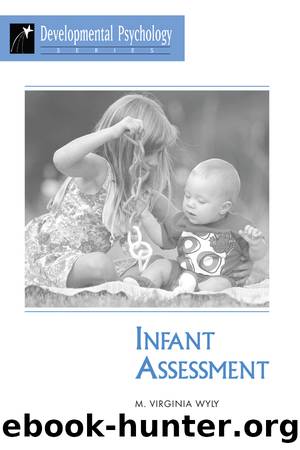Infant Assessment by M. Virginia Wyly

Author:M. Virginia Wyly [Wyly, M. Virginia]
Language: eng
Format: epub
ISBN: 9780367316266
Barnesnoble:
Publisher: Taylor & Francis
Published: 2019-08-28T00:00:00+00:00
Standard-Transformation-Return Procedure
The Standard-Transformation-Return procedure was designed to test infantsâ information-processing ability during a sequential auditory or visual event (Zelazo 1979). In the âstandardâ phase, a given event is repeated in order for the infant to form an expectancy for the event. The event is usually either auditory or visual. An example of a visual event is the car-doll sequence. Here, a small car is rolled down a ramp and pushes over a Styrofoam doll at the bottom of the ramp. The âtransformationâ phase presents the infant with a slightly discrepant event. The toy car is rolled down the ramp, but the doll does not fall over. This is repeated for three or four trials, and then the car rolls down the incline and again knocks down the doll. The reappearance of the standard is called the âreturnâ phase.
In a given STR test, five dynamic sequential events are presentedâthree auditory and two visual stimuli. An example of an auditory sequence is the repetition of a short phrase such as âWave bye-bye.â This is repeated several times, and after several trials, the phrase changes to âThrow me a kiss.â After several trials, the infant again hears the original phrase.
The procedure takes place in a darkened theater, with the infant sitting on the parentâs lap and facing a small lit stage. Observers watch and code the infantâs responses and behaviors. The infantâs capacity to respond to and process the sensory input is measured via behavioral and psychophysiological responses. The speed of the processing of the visual and auditory information is measured in the STR paradigm. Clusters of behaviors shown to reliably signal recognition of discrepant events are recorded (Reznick and Kagan 1982; Zelazo et al. 1974). Behavioral measures include pointing toward the stage, vocalizations, smiling, turning to the parent, clapping, and pointing. Searching behavior during presentation of an auditory sequence is assessed by noting eye widening, head movement, and quieting. Heart rate is also measured through an electrocardiogram (EKG). From the infantâs pattern of behavioral and physiological responses to the events in the test episode, information-processing abilities are inferred. In the cardoll sequence, for example, the standard trials allow the infant to watch a complex visual event. The transformation trials present discrepant information, whereas the return trials provide the opportunity for the infant to âre-memberâ the original event, that is, the car rolling down the ramp and knocking over the doll. An infant watching the return trials might smile, vocalize, and show a heart-rate deceleration. The use of multiple response measures expands the opportunity to assess different styles of recognition of an event. By observing and measuring infantsâ responses in this procedure, it is possible to obtain recognition measures from infants and young children with handicapping conditions that might limit their responses on traditional infant tests. For example, an infant boy with severe cerebral palsy might smile, vocalize, move, and show a heart-rate change when observing the third presentation of the car sequence, indicating that he âsolvedâ the puzzle.
An experimental validation of the
Download
This site does not store any files on its server. We only index and link to content provided by other sites. Please contact the content providers to delete copyright contents if any and email us, we'll remove relevant links or contents immediately.
Through Windows of Opportunity : A Neuroaffective Approach to Child Psychotherapy by Marianne Bentzen; Susan Hart(889)
Overcoming ADHD Without Medication : A Guidebook for Parents and Teachers by Children and Natural Psychology Association for Youth; Children The Association for Youth(826)
Out of the Mainstream: Helping the Children of Parents with a Mental Illness by Loshak Rosemary;(821)
Delphi Collected Works of Sigmund Freud (Illustrated) by Sigmund Freud(580)
The Noom Mindset by Noom(555)
The 48 Laws of Mental Power: Overcoming Trauma and Building Mental Strength by Victor O. Carl(485)
The Psychology of Media and Politics by George Comstock & Erica Scharrer(450)
MANIPULATION & MIND CONTROL: The Persuasion Collection: Dark Psychology Secrets, Analyze & Influence People with Nlp. How to learn Reading Friends and Develop Body Language Skills. by ROBERT TOWER(441)
Sigmund Freud by Janet Sayers;(415)
It's nobody's fault: new hope and help for difficult children and their parents by Harold Koplewicz(404)
Behold the Monster by Jillian Lauren(404)
The Hypnotic Coach: A Conversational Hypnotherapy Tool Kit by Marion Jess(394)
Directions in Technical Writing and Communication by Gould Jay R.;(385)
THE PSYCHOLOGY OF ENTREPRENEURSHIP; New Perspectives by Michael M. Gielnik; Melissa S. Cardon; Michael Frese(360)
Mastering Flow: Perform Better, Experience More Joy, and Live a Happier Life by Nils Salzgeber(350)
Totem and Taboo: Some Points of Agreement between the Mental Lives of Savages and Neurotics by Sigmund Freud(343)
Positive Psychology Across the Lifespan; An Existential Perspective by Piers Worth(338)
Mind Hacking Secrets and Unlimited Memory Power: 2 Books in 1: Learn How to Improve Your Memory & Develop Fast, Clear Thinking in 2 Weeks + 42 Brain Training Techniques & Memory Improvement Exercises by Sharp Scott(333)
The Modern Young Man's Guide to Manhood by Wayne Walker(326)
